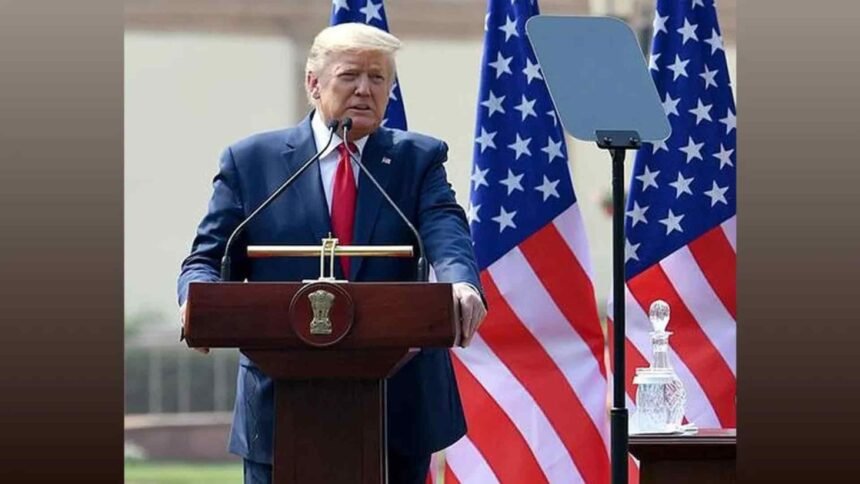Former U.S. President Donald Trump has reignited trade tensions by warning that any country aligning with the “anti‑American policies” of the expanding BRICS bloc will be slapped with an extra 10% tariff, with “no exceptions”
Trump’s announcement came via a Truth Social post late Sunday, July 6, just as leaders were gathering for the BRICS summit in Rio de Janeiro. “Any country aligning themselves with the Anti‑American policies of BRICS, will be charged an ADDITIONAL 10% Tariff. There will be no exceptions to this policy,” he declared. He didn’t clarify what exactly constitutes an “anti‑American policy,” leaving observers puzzled.
Context: U.S. Tariff Strategy and BRICS Expansion
This latest threat builds on Trump’s broader “reciprocal tariff” strategy, which introduced base duties of around 10% on most imports in April, with higher rates — up to 70% on specific goods — planned for August 1 unless new agreements are reached.
Earlier in the year, Trump had warned that BRICS countries trying to weaken the U.S. dollar’s dominance could face 100% tariffs. The 11‑member BRICS bloc—comprising Brazil, Russia, India, China, South Africa, and newer additions like Iran, Saudi Arabia, UAE, Egypt, Ethiopia, and Indonesia—has recently begun exploring alternatives to the U.S. dollar for trade settlements.
Reactions From BRICS Leadership
Leaders at the summit responded sharply:
- Brazilian President Luiz Inácio Lula da Silva dismissed Trump’s move, saying “the world does not want an emperor” and refused to be intimidated by “threats over social media.” He emphasized that “there is no going back” on moving away from dollar dependence through gradual efforts by central banks.
- South African President Cyril Ramaphosa condemned the tariff threat, stating it was disappointing that efforts toward collaboration are met with punitive measures.
- Russia’s foreign minister Sergei Lavrov, standing in for President Putin, argued the U.S. model of globalization is broken and accused Washington of abusing the dollar’s dominance
- China’s foreign ministry spokesperson Mao Ning said that using tariffs as “coercion” is unacceptable and warned that trade wars escalate without winners.
Despite the blistering criticism, BRICS members chose phrasing that called out “unilateral tariff and non‑tariff measures” without explicitly naming Trump or the U.S.
Market Repercussions
Financial markets responded swiftly: The Indian rupee plunged 0.5%, closing at 85.85 per dollar, its lowest level in three weeks. The South African rand and Chinese yuan also slipped amid investors’ growing concern over rising trade barriers.
Analysts warned that further volatility could prompt intervention from central banks like the RBI to stabilize their currencies. With stop‑loss orders triggered, the rupee could weaken further toward 86.50 unless markets calm .
Strategic Implication: A Clash of Trade Philosophies
At its heart, the clash reflects a deep-rooted struggle between Trump’s “America First” unilateralism and BRICS’s emerging push for multilateral frameworks. Trump asserts that the U.S. has lost global leverage and is leveraging tariffs as a tool to restore that influence.
By contrast, BRICS leaders promote a rebalanced global economic order, advocating for reforms at the UN, IMF, and World Bank, and resisting dollar-centric trade mechanisms.
Next Moves: Diplomatic Ramifications
Trump’s administration is poised to send letters by July 9 detailing country-specific tariffs, with the extra BRICS-related duties scheduled to roll out from August 1, if no exemptions are pronounced.
While Trump indicated several trade deals—including with the UK, China, and Vietnam—would be finalized by the July 9 deadline, it remains unclear whether tie‑ups with BRICS-aligned nations will be reached.
BRICS affiliates like Indonesia are already negotiating with Washington—Indonesia’s economic minister is heading to the U.S. this week for talks on its potential exposure . India and Malaysia, meanwhile, have been stockpiling diplomatic leverage and engaging proactively to mitigate any adverse impact .
What’s at Stake
- Emerging economies: For BRICS countries, the tariff threat could raise costs on exports and reduce access to North American markets.
- Global supply chains: Elevated trade barriers can trigger disruptions, raising costs for manufacturers and consumers.
- Geopolitical alignment: The dispute may force nations to weigh their strategic stance—toward U.S.-close cooperation or deeper engagement with BRICS.
Trump’s threat of a 10% surcharge on nations aligning with BRICS introduces a new layer to the ongoing trade saga. It escalates retaliation beyond tariffs already scheduled and signals a readiness to penalize countries based on political alignment. As global markets and diplomatic channels brace for impact, August 1 looms as a critical date—unless underlying disputes are defused through negotiations.






